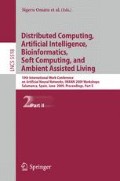Abstract
An approach to the inverse protein folding problem is described which combines a simulated annealing algorithm with template matching using the Bellman criteria. Solutions to proposed target structures are found by iteratively constructing the most similar solution. The folding model is based upon the traditional 2D HP protein lattice with a modified Viterbi dynamic programming algorithm. Initial results of both the optimal folding problem and the inverse protein problem are presented.
Access this chapter
Tax calculation will be finalised at checkout
Purchases are for personal use only
Preview
Unable to display preview. Download preview PDF.
References
Bellman, R.E.: Dynamic Programming. Princeton University Press, Princeton (1957)
Berger, B., Leighton, T.: Protein folding in the hydrophobic-hydrophilic (HP) is NP-complete. In: Proceedings of the second annual international conference on Computational molecular biology, pp. 30–39 (1998)
Berloff, N.G.: Nonlinear dynamics of secondary protein folding. Phys. Lett. A 337, 391–396 (2005)
Candru, V., DattaSharma, A., Anil Kumar, V.S.: The algorithmics of folding proteins on lattices. Discrete Appl. Math. 127, 145–161 (2003)
Chan, H.S., Dill, K.A.: The Protein folding problem. Physics Today 46(2), 24–32 (1993)
Deutsch, J.M., Kurosky, T.: New Algorithms for Protein Design. Phys. Rev. Lett. 76(2), 323–326 (1996)
Dill, K.A.: Theory for the folding and stability of globular proteins. Biochemistry 24(6), 1501–1509 (1985)
Grassberger, P.: Pruned-enriched Rosenbluth method: Simulations of θ polymers of chain length up to 100000. Phys. Rev. E 56(3), 3682–3693 (1997)
Itakura, F.: Minimum prediction residual principle applied to speech recognition. IEEE Trans. Acoustic Speech. and Signal Proc. 23(2), 67–72 (1975)
Lau, K.F., Dill, K.A.: A lattice statistical mechanics model of the conformational and sequence spacres of proteins. Macromolecules 22(10), 3986–3997 (1989)
Park, B.H., Levitt, M.: The complexity and accuracy of discrete state models of protein structure. J. Mol. Biol. 249, 493–507 (1995)
Pelta, D., Carrascal, A.: Inverse protein folding on 2D Off-Lattice Model: Initial Results and Perspectives. In: Marchiori, E., Moore, J.H., Rajapakse, J.C. (eds.) EvoBIO 2007. LNCS, vol. 4447, pp. 207–216. Springer, Heidelberg (2007)
Sako, H., Chiba, S.: Dynamic programming algorithm optimizations for spoken word recognition 26(2), 43–49 (1978)
Santana, R., Larrañaga, P., Lozano, J.A.: Protein Folding in Simplified Models with Estimation of Dsitribution Algorithms. IEEE Trans. Evol. Comp. 12(4), 418–438 (2008)
Theodoridis, S., Koutroumbas, K.: Pattern Recognition, 2nd edn. Elsevier Press, San Diego (2003)
Author information
Authors and Affiliations
Editor information
Editors and Affiliations
Rights and permissions
Copyright information
© 2009 Springer-Verlag Berlin Heidelberg
About this paper
Cite this paper
Olivieri, D. (2009). Iterative Lattice Protein Design Using Template Matching. In: Omatu, S., et al. Distributed Computing, Artificial Intelligence, Bioinformatics, Soft Computing, and Ambient Assisted Living. IWANN 2009. Lecture Notes in Computer Science, vol 5518. Springer, Berlin, Heidelberg. https://doi.org/10.1007/978-3-642-02481-8_179
Download citation
DOI: https://doi.org/10.1007/978-3-642-02481-8_179
Publisher Name: Springer, Berlin, Heidelberg
Print ISBN: 978-3-642-02480-1
Online ISBN: 978-3-642-02481-8
eBook Packages: Computer ScienceComputer Science (R0)

